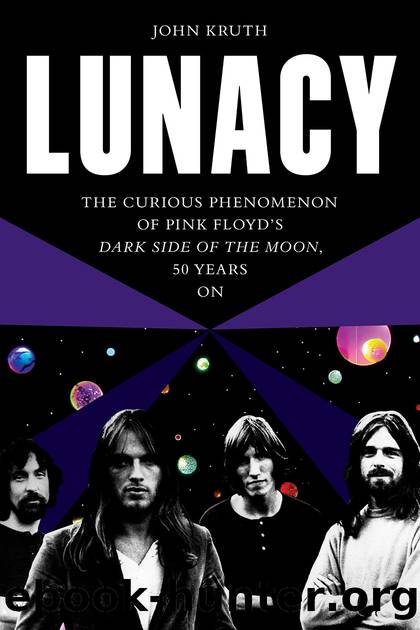Lunacy by John Kruth

Author:John Kruth
Language: eng
Format: epub
Publisher: Backbeat
Published: 2022-11-13T00:00:00+00:00
Originally referred to as âThe Religious Sectionâ or âThe Mortality Sequence,â âThe Great Gig in the Skyâ was inspired by Rick Wrightâs fear of dying while on tour, whether in a plane crash or âon the motorways of America and Europe,â as he explained.
Early bootleg recordings from Pink Floydâs live shows reveal that âGreat Gigâ was once a very different piece of music from the track that closes side one of Dark Side of the Moon. First conceived as a dreamy organ fugue for Antonioniâs Zabriskie Point but rejected by the finicky director, âThe Mortality Sequenceâ provided a much-needed respite from Pink Floydâs sonic onslaught during their live shows, while shining the spotlight on Wrightâs ethereal organ playing for a few minutes.
Pink Floydâs creative quest was always in a state of flux. Like jazz musicians, their mode of composing often relied on their ability to improvise together as a unit, although the Floydâs method was more laborious and costly than that of artists like Miles Davis and John Coltrane, whose extraordinary musicianship allowed them to spontaneously compose onstage and in the studio.
âAs a guitarist, itâs a constant question I face,â Robert Musso muses. âAm I going to improviseâdo one or two takes and play freeâor am I going to get compositional and create parts? Am I harmonically and rhythmically correct and serving the composition? I always try to do both.â
Pink Floyd often arrived at Abbey Road with little more than a foggy notion of what their next album might be. âBasically, weâre the laziest group ever,â Gilmour quipped, unabashedly unapologetic for wasting expensive studio time and burning through record company budgets.
Eventually, the Floydâs crazy quilt of half-finished lyrics, riffs, and rhythms would take the shape of songs, as in the case of âEchoes,â which initially began as a few vague ideas first dubbed âNothing,â then growing into âThe Son of Nothingâ and finally âThe Return of the Son of Nothing,â before blossoming into the side-length track that became their most significant post-Barrett recording to date.
Similarly undefined was the role of their young engineer/producer Alan Parsons, whoâd previously worked on Atom Heat Mother, the Beatlesâ Let It Be and Abbey Road, and Paul McCartneyâs debut solo album, McCartney. While he is credited on the album sleeve as âengineer,â Parsons helped expand that role by âmaking criticisms or suggestions that would normally be made by a producer,â as he later recalled.
âSometimes I did and sometimes I didnât (keep my big mouth shut),â Parsons admitted. One of his brainstorms of a lesser magnitude was to mix recorded fragments of the 1969 moon landing throughout the albumâan idea that was quickly (and wisely) dismissed by the band, as it would have forever linked Dark Side of the Moon to that historic event, rather than leaving the work open to listenerâs interpretation.
While Pink Floyd often had âno idea of what they were going to do,â Parsons was relieved to find that, with Dark Side, rather than enduring the bandâs usual process of endless jamming and
Download
This site does not store any files on its server. We only index and link to content provided by other sites. Please contact the content providers to delete copyright contents if any and email us, we'll remove relevant links or contents immediately.
| Biographies | Business |
| History & Criticism | Instruments |
| Musical Genres | Recording & Sound |
| Reference | Songbooks |
| Theory, Composition & Performance |
The Goal (Off-Campus #4) by Elle Kennedy(13462)
Kathy Andrews Collection by Kathy Andrews(11706)
Diary of a Player by Brad Paisley(7458)
What Does This Button Do? by Bruce Dickinson(6121)
Assassin’s Fate by Robin Hobb(6101)
Big Little Lies by Liane Moriarty(5677)
Altered Sensations by David Pantalony(5027)
Pale Blue Dot by Carl Sagan(4883)
Sticky Fingers by Joe Hagan(4083)
The Death of the Heart by Elizabeth Bowen(3530)
The Heroin Diaries by Nikki Sixx(3478)
Beneath These Shadows by Meghan March(3248)
Confessions of a Video Vixen by Karrine Steffans(3229)
How Music Works by David Byrne(3157)
The Help by Kathryn Stockett(3066)
Jam by Jam (epub)(3003)
Harry Potter 4 - Harry Potter and The Goblet of Fire by J.K.Rowling(2971)
Strange Fascination: David Bowie: The Definitive Story by David Buckley(2781)
Petty: The Biography by Warren Zanes(2681)
